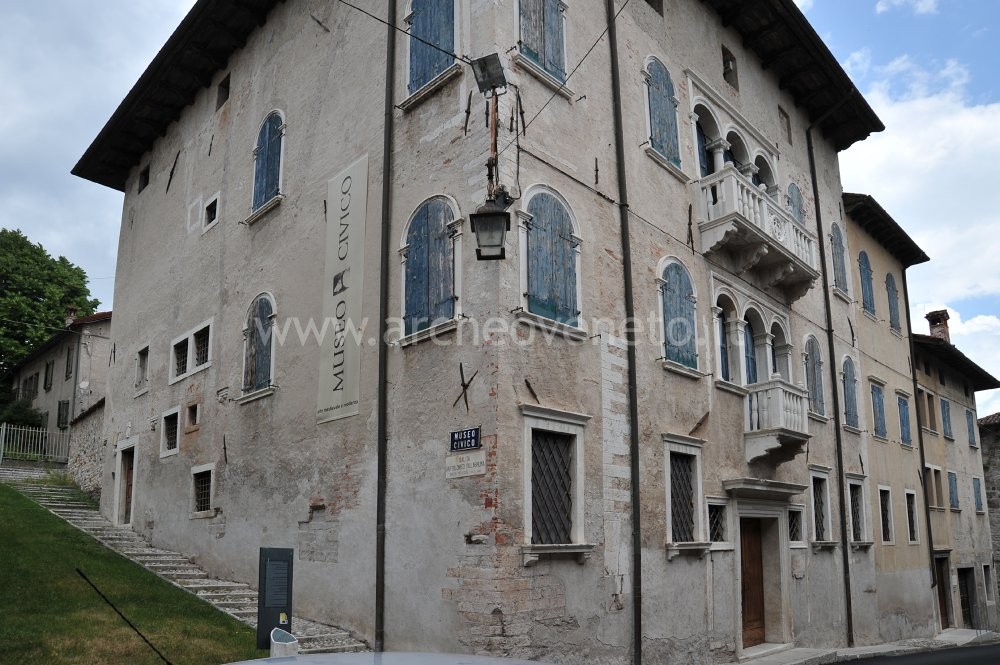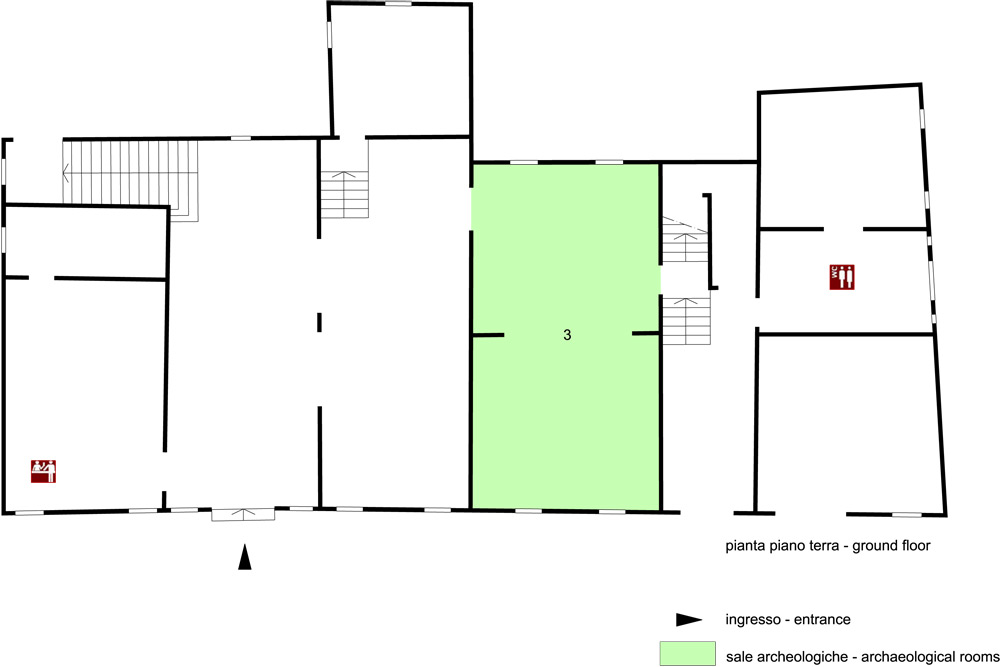|
|
File
Civic Museum – Feltre
|
Via Lorenzo Luzzo – 32032 Feltre (BL)
– Fax 0439 885246 |
  |
|
Summary

The Archaeological Section of the Civic Museum is located on the ground floor of the Renaissance Palace of the Villabruna family in the old city centre of Feltre. The exhibition, which mainly displays Roman materials found in the area surrounding the municipality of Feltre, is currently being re-organized. Particularly noteworthy for their historical and documentary importance are two fragments of Rhaetic inscriptions, an altar with an inscriptions to the old Italic deity Anna Perenna and the base of a statue representing the prestigious Caius Firmius Rufinus, one of the few traces proving the existence of the ancient Berua, a village of Rhaetic origin in Veneto, the exact location of which remains still unknown.
Collection history
The Civic Museum of Feltre, established in 1903, was moved to its current venue, in the Villabruna Palace, in 1922; the expositive plan of the museum was accomplished by the architect Alberto Alpago Novello and the museum was officially opened in 1928. Between 1944 and 1952 the collections were further enlarged and in 1952 Giulia Fogolari commissioned the creation of the Archaeological Section. Re-organization works and structural adjustments were carried out in 1954 and 1997 throughout the museum. The Archaeological Section is currently being re-organized, as it is going to include new materials from the excavation carried out in the archaeological site of Piazza Duomo.
|

 The room is currently being reorganized. The room is currently being reorganized.
Beside the items of the Roman age discovered in the area around Feltre, there are also two important finds that can be traced back to the late Iron age (3rd-2nd cent. B.C.). They consist of two fragmented inscriptions displaying the use of the Rhaetic language and writing, one of which was discovered in 1893 in the area of the nunnery of the Canossians.
The Roman materials include numerous architectural elements (column shafts, Corinthian-Italic capital, Ionic-Italic capital, fragment of a large circular base, etc.) and decorative elements (marble drinking fountain) bearing witness to the impressive architectural heritage, but also inscriptions, fragments of sculptures and stone quern components.
As regards the inscriptions, a white limestone altar devoted to the Italic deity Anna Perenna (1st cent. A.D.), which was discovered in 1922 in the square in front of the cathedral, is particularly important, as it can be considered an expression of the recovery (already carried out in ancient times) of the alleged Rhaeto-Etruscan roots of the local Alpine peoples. Particularly important from the historical point of view are also the funerary stele of the brother and father of Lucius Oclatius Rocianus, which mentions the Menenia tribe (which included also the municipium of Feltre) and a statue base with an inscription to Caius Firmius Rufinus, patron of the collegia (professional associations) of fabri, centonarii and dendrophori from Feltre and Berua and the collegium of fabri from Altinum (2nd cent. A.D.): it is one of the few finds proving the existence of the ancient Berua, a village of Rhaetic origin in Veneto, the exact location of which is still unknown.
The marble sculptures include: a marble comic mask (late 1st cent. A.D.), a statue representing an ephebos (late 1st – first half of the 2nd cent. A.D.), a copy of the Greek original of the 5th cent. B.C.; a marble male portrait-head (early 2nd cent. A.D.); a bas-relief of unknown origin depicting a young boy (2nd cent. A.D.), which was donated by earl Jacopo Dei and a large statue of Asclepius without head (2nd cent. A.D.), which was discovered during the excavation in Piazza Duomo. There is also an interesting earthen antefix with veiled female head of the Republic age, found in the site “Ai folli” in 1915 or 1918.
|

Admission: Negli orari di apertura
Su prenotazione
Ticket: Si
Price: Full fare ticket: 4 €; full fare through ticket (including the “Carlo Rizzarda” Modern Art Gallery): 5 €; reduced fare (school classes): 1.50 €: reduced fare (for school classes) through ticket (including the “Carlo Rizzarda” Modern Art Gallery): 2.50 €.
Reduced fare: children below 18 years, university students up to 26 years and upon presentation of a valid student card; seniors 60+, groups (min. 15 people). Free admission: journalists upon presentation of their press card; children below 8 years of age; escorts and/or tour guides of organized tourist groups; tourist interpreters, only if the guide needs translation services; people with disabilities and their helpers, if any.
 School access School access
 Disabled access Disabled access
The entrance equipped with a ramp is located on the right side of the main entrance door.
Parking space for disabled in front of the museum.
Opening Days
| Tipology |
When |
Specs |
| Summer |
Tuesday |
Upon reservation for groups of 15 or more persons and schools |
| Summer |
Wednesday |
Upon reservation for groups of 15 or more persons and schools |
| Summer |
Thursday |
10.30-12.30, 16.00-19.00 |
| Summer |
Friday |
10.30-12.30, 16.00-19.00 |
| Summer |
Saturday |
10.30-12.30, 16.00-19.00 |
| Summer |
Sunday |
10.30-12.30, 16.00-19.00 |
| Winter |
Tuesday |
Upon reservation for groups of 15 or more persons and schools |
| Winter |
Wednesday |
Upon reservation for groups of 15 or more persons and schools |
| Winter |
Thursday |
10.30-12.30, 15.00-18.00 |
| Winter |
Friday |
10.30-12.30, 15.00-18.00 |
| Winter |
Saturday |
10.30-12.30, 15.00-18.00 |
| Winter |
Sunday |
10.30-12.30, 15.00-18.00 |
Closed on monday, tuesday, wednesday (if not holiday), 25 and 26 December, 1 January.
Recommended tour time (minutes): 15
 Toilet Toilet
 Bookshop Bookshop
Books on archaeology are not for sale.
 Mobile cards Mobile cards
Several copies of an information sheet are available in the entrance hall (Room 1)
 Captions under exhibits Captions under exhibits
Only of some works.
 Educational activities Educational activities
Didactic visits
 Library and documentation centre Library and documentation centre
| Musei e raccolte archeologiche del Veneto 2004, a cura di Di Mauro A., Dosson di Casier, pp. 33-34. |
| Bonetto J. 2009, Veneto (Archeologia delle Regioni d’Italia), Roma, pp. 424-425. |
|



 School access
School access Disabled access
Disabled access Mobile cards
Mobile cards Captions under exhibits
Captions under exhibits Educational activities
Educational activities Library and documentation centre
Library and documentation centre








